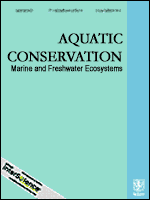Salty stories, fresh spaces: Lessons for aquatic protected areas from marine and freshwater experiences
 Authors: Loury, E. K., Ainsley, S. M., Bower, S. D., Chuenpagdee, R., Farrell, T., Guthrie, A. G., Heng, S., Lunn, Z., Mamun, A. A., Oyanedel, R., Rocliffe, S., Satumanatpan, S. and Cooke, S. J.
Authors: Loury, E. K., Ainsley, S. M., Bower, S. D., Chuenpagdee, R., Farrell, T., Guthrie, A. G., Heng, S., Lunn, Z., Mamun, A. A., Oyanedel, R., Rocliffe, S., Satumanatpan, S. and Cooke, S. J.
This paper builds on a session held at the 7th World Fisheries Congress in Busan, South Korea, in May 2016, which explored crossover lessons between marine and freshwater realms, and included case studies of four MPAs and five FPAs (or clusters of FPAs) from nine countries. The review uses the case studies to explore similarities, differences, and transferrable lessons between MPAs and FPAs under five themes: (1) ecological system; (2) establishment approaches; (3) effectiveness monitoring; (4) sustaining APAs; and (5) challenges and external threats.
The study shows that ecological differences between marine and freshwater environments may necessitate different approaches for collecting species and habitat data to inform APA design, establishment and monitoring, but once collected, similar spatial ecological tools can be applied in both realms. In contrast, many similarities exist in the human dimension of both MPA and FPA establishment and management, highlighting clear opportunities for exchanging lessons related to stakeholder engagement and support, and for using similar socioeconomic and governance assessment methods to address data gaps in both realms.
The review also illustrates that regions that implement MPAs and FPAs could work together to address shared challenges, such as developing mechanisms for diversified and sustained funding, and employing integrated coastal/watershed management to address system-level threats. Collaboration across realms could facilitate conservation of diadromous species in both marine and freshwater habitats.
An online summary of the paper can be found HERE.















